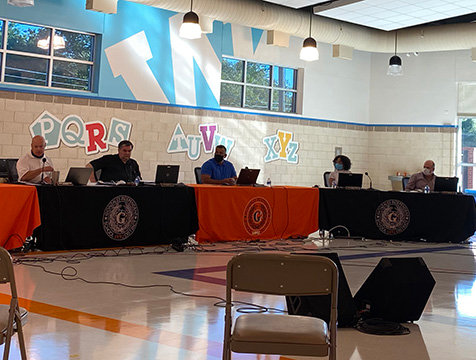GISD implementing changes in scheduling, class size amid COVID-19
The Gonzales Independent School District Board of Trustees met Monday evening to discuss preparations for the new school year in light of COVID-19.
Superintendent John Schumacher said that the district is considering two models of learning in addition to changing the way school schedules look and implementing COVID-19 screenings on campuses.
“The physical distance of our students and our staff is going to be imperative,” Schumacher said. “Even more imperative, I think we have it, that you are safe enough and I want to ensure you’re comfortable and safe enough that if you’re in this room or any classroom, you can be there and we’re going to require that our students from third grade on up have masks.”
Schumacher said that while it is encouraged for students to bring their own personal protection equipment in the form of masks, students who arrive without a mask would be supplied with them. Staff and faculty will also be wearing masks.
He also said that class sizes will be made proportional to the size of available classrooms to ensure students, staff and faculty are able to effectively social distance.
“If it's smaller room, then a smaller class size, the bigger the room, the more students but the spacing is going to be critical,” Schumacher said. “And then of course, outside is a good place to be when we can be.”
There are several options being examined by the district in terms of reducing student mobility while at school, to limit contact and possible viral spread. Schumacher also said that plans are in motion to ensure students are screened multiple times a day: when they are picked up by the bus, when they enter the school, possibly at lunch, and before they leave. The thermometers necessary, Schumacher said, are around $60 each.
“We believe that the cost of the thermometers and the cost of these separate items that we need will be very helpful.” Schumacher said. “The big headache is if a student has a fever, and we want to check that up to three times a day, but again, the first one is going to get hit by the bus. We’re going to want to work with parents and we want to communicate to parents, we would like them to be with your child. Why? When the bus driver checks that child and their fever is at 100 or plus, they’re not coming to school.”
In addition to these extra safety precautions, students will only have four or five classes every day, possibly remaining in one classroom for the whole day while teachers alternate for different courses.
As for digital learning, the district is considering both asynchronous and synchronous models. In an asynchronous learning plan, students’ attendance and participation would be task-based, requiring the completion of an assignment or participation in a discussion board. Synchronous learners would be required to log into a service such as Zoom or Google Classroom, in order to be counted present. Both models require students to complete coursework just like if they were on campus. The Board’s decision to supply students with Chromebooks and iPads by grade level also allows for quicker returns on exam results and performance reviews, Schumacher said. This way, teachers can still keep up with their students if schools are not reopened.
“Now, I expect it's going to change in a week or two again,” Schumacher said of the plans to reopen Texas schools in the fall. “It’ll be basically, the governor says, ‘we're not having a school in person.’ That's cool. We're going to be ready. We were planning on having our Chromebooks the second week of August.”
Comments







